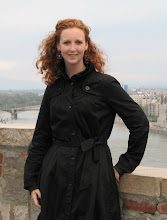Now I'm trying to figure out how I would organize my family's history. I think the first story is the story of the Wises (my mom's dad John H. Wise and his dad John L. Wise and his dad Israel M. Wise and his dad Jacob F. Wise and his dad John L. Weisz and his dad Killian Weiss and his dad George Weiss, Jr. and his dad the Rev. George Weiss).
So far this blog has concentrated on my maternal grandmother's family - the Hartmans (since most of the books belonged to them). I've only written one post about "The Other Side," my maternal grandfather's family - the Wises.
Gertrude Mohlin Ziegler wrote a very informative book called "The Ziegler Family and Related Families in Western Pennsylvania" (Charles Campbell Printing Company 1978). In it, she summarizes the Weiss-Weisz-Wise family's arrival in America:
"The Weiss-Weisz-Wise Family in America traces its ancestry back to the Emigrant, George Weiss (1687-1740) who was married to Anna Meschter. George, son of Caspar Weiss, was born in Harpersdorf, Lower Silesia. He came to America in the early 1700's, settling first at Germantown. He was the first minister to be elected (November 9, 1735) of the Schwenkfelder Group. The Schwenkfelder Group takes its name from Caspar Schwenkfeld (1490-1562) of Silesia. 'He and Martin Luther sharply disagreed on the nature of Christ's presence in the Lord's Supper.' (See Wenger's "History of the Franconia Menonites.") They opposed war and oaths, advocating separation of church and state, like the Mennonites. They, too, were persecuted for their beliefs and fled to America between 1731-1737.I've found a few other references to Rev. George Weiss, but they don't all agree. Pages 59 to 61 of "The Schwenkfelders in Pennsylvania: A Historical Sketch" by Howard Wiegner Kriebel (New Era Printing Company, 1904) describe how George Weiss became minister of the Schwenkfelders. Two pages of a document copied to rootsweb.com also talk about George Weiss, but claim he had no descendants. I'm hoping that a visit to the Schwenkfelder Library & Heritage Center will clear things up.
Two sons of Rev. George Weiss were George Jr. and Killian. Killian and Sarah Weiss had no issue. George Jr. had two sons and five daughters. The sons were Jacob who married Sarah, and Killian (1751-1840) who married Catherine Ziegler Landis (1764-1826). The Weisz and Wise families who emigrated into Butler County, PA., and Ohio descend from Michael Ziegler and George Weiss through these lines."
I don't know much about George Weiss, Jr. Was he involved in the Schwenkfelder community? Did he stay in the Germantown area where his father lived? He had a son named Killian Weiss who was born in 1751 and died in 1840 in Montgomery County, which is still pretty close to Germantown. Killian's son John Landis Weisz made the move from Eastern to Western Pennsylvania. He was born in 1790 in Montgomery County and died in 1856 in Beaver County.
 The story fills out with his son, my great-great-great-grandfather Jacob Funk Wise (pictured), who bought a farm in Harmony, PA (Butler County). There's a 50-page pamphlet that was published in 1962 called "History of the Descendants of Jacob Funk Wise." It describes Jacob Funk Wise as a farmer and drover. In 1886, he bought a farm called "Drovers' Inn" which is still in the family. My grandma and grandpa and aunt and uncle live on the farm now, which was operating as a dairy farm until about a decade ago.
The story fills out with his son, my great-great-great-grandfather Jacob Funk Wise (pictured), who bought a farm in Harmony, PA (Butler County). There's a 50-page pamphlet that was published in 1962 called "History of the Descendants of Jacob Funk Wise." It describes Jacob Funk Wise as a farmer and drover. In 1886, he bought a farm called "Drovers' Inn" which is still in the family. My grandma and grandpa and aunt and uncle live on the farm now, which was operating as a dairy farm until about a decade ago.





